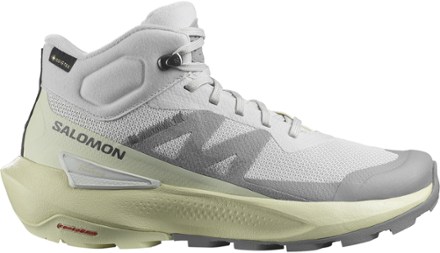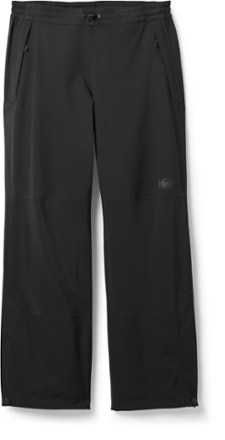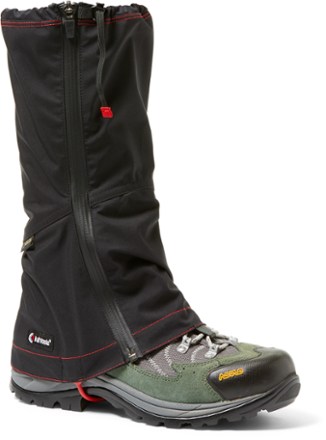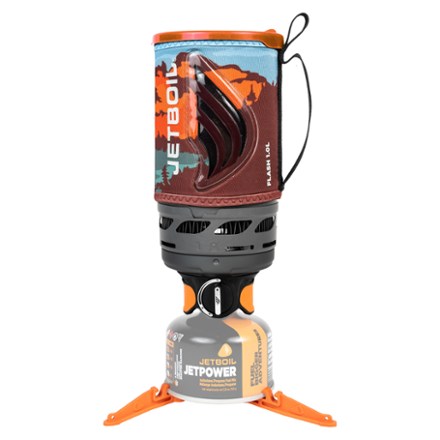
Spring Hiking Gear List:
Mud And Cold Showers, Here We Come
By Diane Spicer
A spring hiking gear list makes good sense as you plan hikes during the transitional season of fast changing weather and variable trail conditions.
Regardless of where you hike, spring can toss windy gusts, cold precipitation, lots of mud, and fog at you.
And that's on a good day!
Get ready to meet all of that gracefully, as you understand what to wear hiking and what to have in your backpack for spring conditions.
Here's the overview of a spring hiking gear list
Your basic spring hiking gear list includes:
- Backpack with rain cover
- Ten Essentials
- Clothing layering system, ending with waterproof or water repellent outer layer
- Waterproof boots & technical hiking socks
- Hiking gaiters
- Trekking poles
- High calorie food
- Water, or a way to treat surface water
- Navigational and communication technology
See details & additions to list plus my recommendations:
And here's a shocker (not): That list works great for cool fall trails, too!
Choose from these spring hiking gear combinations
Where you hike influences your spring hiking gear list.
And who you are as a hiker is also going to dictate exactly what you wear on a spring hike, and what you carry in your backpack.
Let's pull together a few combinations to give you an idea of how to keep yourself warm and dry despite trail conditions as winter gives way to spring.
For wet, muddy spring day hikes
You need to keep the mud at bay and stay upright on slick trails, while keeping your skin and your gear as dry as possible during your hike.
Here's one spring hiking gear combo to achieve those goals:
|
Salomon Elixir Activ Mid GORE-TEX Hiking Boots great traction & waterproof protection on spring trails |

|
|
Osprey Sirrus 24 Day Pack not too big or bulky, just right for a day hike with its raincover included. |

|
|
REI Co-op Rainier Full Zip Rain Pants available in petite and tall lengths, too 
|
Black Diamond Trail Trekking Poles You're gonna need these to cross creeks and navigate through the mud! 
|
Layering options for plus size day hikers
On top of weather and trail challenges, you have to deal with the lack of sizing in your clothing layers.
Try these versatile high performance outer layers:
|
REI Co-op Flash Stretch Rain Jacket Sizing through 3X 
|
REI Co-op Flash Stretch Rain Pants Sizing through 3X 
|
For backpackers in cold and/or wet spring conditions,
add these to your spring hiking gear list
You'll be pushing hard with short days and iffy weather conditions, so treat your feet right and bring a great outer layer.
Keeping your camping gear accessible and dry, also a top priority!
Gregory Deva 70 Pack

Your choice of backpacking stove and shelter for spring backpacking trips are also important to get just right.
The REI Co-op Trail Hut 2 Tent with Footprint is a great choice for its lower price point, easy set up, 2 large D doors with integrated venting, plus internal storage pockets and gear loops.
Throw on the rain fly, and you've got yourself covered for three season backpacking!

Looking to go ultralight with your tent?
Spring hiking gear list:
the 3 basic pillars to successful hiking
Now let's dig into the details for your spring hiking needs!
Those are the 3 main pillars of your basic spring hiking gear list.
To begin, let's stick with the basics of comfort and safety.
We'll add in fun items at the end, because it's always important to have fun on a hike, right?
To start building your list, let's get a few things out in the open about hiking in cool weather conditions.
Basic facts for happy spring hiking
If you hike year round (snowshoe hikes, winter hiking, or strenuous daily walks in a nearby park) you are probably conditioned to cold temperatures.
But if you're just starting off your hiking year with a spring hike or two, don't be caught off guard by how chilly and damp it can feel - especially if you're hiking under evergreen tree cover or in a place where spring cloud cover is the norm.
It might also surprise you to know that temperatures plunge about three and a half degrees for every thousand feet of elevation gained, something to be prepared for (mentally and physically) on a mountain trail that starts low and ends high.
All of this adds up to being prepared for wild temperature fluctuations plus moisture.
And that's where clothing technology comes in.
Comfortable clothing to put on your spring hiking gear list
To stay comfortable on a chilly hike, choose a spring hiking outfit that will layer easily to provide at least 3 layers between you and the cold spring drizzle.
- Base layer: no need for long underwear, but don a pair of leggings and a well fitted sports bra. If you aren't prone to feeling the chill of spring on your lower body, skip the leggings.
- Mid layer:
a long sleeve wicking shirt and water repellent nylon pants. Depending
on temperature, a pull over fleece top in a mid-range weight is also
great to handy in your pack.
- Outer layer: a water proof jacket and rain pants should ride along in your backpack until you need them. See above recommendations for great layering choices!
Not sure which brands and styles are best?
Wondering about which fabrics make sense for spring trails?
- Read these tips on exactly what to wear hiking.
Trail Tip
Bookmark this page and return to it for fall hiking tips, too.
- Or use this extensive Hiking For Her fall hiking clothing and gear guide.
- Cool, wet weather happens at both ends of summer trails, right?
Add extra protection from the elements to your spring hiking list
If you get cold easily, beef up your spring hiking clothing list with cozy fleece gloves like these and a balaclava.
- Don these when you stop moving, to ward off hypothermia.
- More tips on how to keep hands warm here
- And tips on toasty feet :)
To insulate your torso, use a hiking vest that can be taken off when you're feeling warmer.
And spring is when a waterproof rain cover like this one for your hiking backpack comes into play big time.
- As soon as the first raindrops hit your head, stop and pull out the cover to keep your Ten Essentials dry and usable.
- Time to put on your hiking hat, too!
Moral of the story for springtime hikers:
Stay warm, don't try to get warm once it's too late.
Safety basics for a spring hike
In spring, you'll be facing winter run off and snow melt.
That means wet conditions for your feet, along with unstable trail conditions such as mud holes, rock slides, eroded tread, slippery tree roots, and swollen impassable creeks.
Sounds like a blast, doesn't it?
 Sometimes you just can't avoid stepping on slippery tree roots on a spring hike
Sometimes you just can't avoid stepping on slippery tree roots on a spring hikeWaterproof footwear that comes up over your ankles is the way to go, quite literally.
- See the recommendations above for boots that will go the distance with you.
Hiking gaiters protect your pants and backside from mud splatters and snow.
- Recommended gaiters, see above
It's much better to blast through the mud, and carefully pick your way around dicey (and maybe icy) sections of trail, in snug boots with good tread.
- Carry boot traction devices and don them when needed.
If you hike where mosquitoes are a nuisance, spring is a great time to check your supply of insect repellents.
Also consider whether or not to bring a bug net on your hike. It weighs nothing, but can keep you sane and safe from the blood thirsty hordes.
The days are still short, especially with rainy weather, so carry a headlamp like this inexpensive but powerful one.
Safe hiking water crossings
As a smart hiker, you've consulted your map before you even left home.
You know how many water crossings there are.
You might even have a rough idea if any of them are without bridges.
- Always be prepared psychologically for a washed out bridge.
- Just because it's marked on a map, or noted in a trail description, does not guarantee that it will be there for you.
If you plan to rock hop through the roaring creeks, think again.
Any time you hop, you put yourself at risk for a fall.
- If you have to do it while backpacking, use your trekking poles for stability and to probe ahead of your feet.
And skip slimy logs altogether.
If a water crossing looks too wild for you, do the smart thing: turn around.
- That's the good thing about creeks and rivers: they'll be there waiting for you next time ;)
Mark the trail in your hiking journal for later in the season, when the crossing will be as easy peasy as possible.
- Practice your water crossing skills during those low water levels, until your confidence in reading spring water levels is strong.
More spring hiking safety tips
In the spring season, more daylight hours and modulated temperatures will make your trail time longer.
Also harder.
So you need to bring extra food and water (as the Ten Essentials above preaches).
There are tips waiting for you below.
You also need to be careful about gauging the weather.
- A spring day may start out sunny and clear, and by the time you're a few miles or kilometers into your hike the skies could be overcast and spitting on your head.
- Read up on the fundamentals of safe hiking weather.
- Check the forecast before you leave for the trailhead, using the free resources here. Promise? Good!
Now add some fun
to your spring hiking gear list
Spring is Mother Nature's time to wake up and stretch.
Revel in all of the shades of green surrounding you!
It's also the time to catch a glimpse of spring babies:
- Hatchlings making a racket in a nest towering over your head
- Shy fawns peeking from behind mom's legs
Bringing along a field guide on a spring hike adds a lot of enjoyment when you spot a plant you'd like to name, or a bird perched along the trail.
- Favorite hiking field guide suggestions, right here!
Please budget time for simply breathing, listening, and drinking in all of the fresh odors and textures of a spring trail.
- Sit on a dry rock, just off the trail, and keep your senses tuned for what happens after ten minutes of silence.
In wild spring weather patterns, rainbows are a common occurrence, so have your camera along in your hiking camera pack.
- It makes sense to carry your photography equipment in a dedicated pack, out of the stormy and wet conditions.
 Your pot of gold at the end of this rainbow is somewhere over the trail
Your pot of gold at the end of this rainbow is somewhere over the trail
Spring hiking gear list:
worthy additions for comfort and safety
Every hiker has a particular set of "must have" hiking equipment, depending on what spells comfort, safety and fun for you on the trail.
Don't be shy about adding the gear that makes you feel great on a spring hike, as long as the weight of your backpack does not affect your trail performance.
Examples:
Bring a backpacking chair to sit on at your spring campsite.
- An indulgence? Sure!
- But you're worth it.
Or use a lightweight cushion like this Therm-a-Rest Z-Seat pad between you and the damp, cold rocks during a lunch break.
Personal favorites on my spring hiking gear list
My favorite comfort item on a spring hike?
A piping hot drink to enjoy when my hands and feet get cold. It also adds to safety, keeping hydration levels high.
- A double walled Hydroflask carries the hot water.
- I add my favorite tea bag to my cup (green tea has lots of antioxidants!), and enjoy a freshly brewed steaming cup right there at my lunch spot.
Or brew up a fresh cup with your Jetboil.
Food is a safety item AND a comfort item
on your spring hiking gear list
You might be surprised by the amount of calories your body will burn through just to keep your internal temperature steady.
And that translates into a huge appetite.
Be prepared with extra portions of your hiking lunch.
- These tips will get you ready.
And take these Hiking For Her hiking snack suggestions seriously - they're chosen for taste but also for nutrient density to keep you going.
Bring at least a liter of water (in a bottle or hydration backpack) for a day hike, and feel smug about having a bit left over when you get back to the trail head.
- Just kidding! Drink freely as you hike to ward off dehydration issues that can creep up on you in cool weather.
You might also be surprised by your lack of thirst on cool weather hikes. Vow to drink often, whether or not you feel a thirst sensation.
- Hydration tips here
Don't want to carry the weight of adequate supplies of water? You can treat surface water using these methods.
Tip:
One of the quickest, easiest ways to treat water on a hike is a personal water filtration unit.
- Read my LifeStraw review here.
Critical navigational technology
Face it, even a well known trail will look different in foggy or flooded conditions.
If there's a layer of snow and mud over any of it, be prepared to lose the trail at least once.
That's why it's critical to carry solid navigational tools, and know their limitations.
A map and compass, great! As long as you know how to use the combo, and the map is the correct scale and location (you did verify that before you hit the trail, I know you did).
Cell phone with GPS app? Not going to cut it for most hiking, in my estimation. Way too much can go wrong: cold temperatures sapping the battery, for one.
Garmin is a trusted name in GPS and GLONASS satellite systems hand held navigational gear for hikers and backpackers. Their varied line of products, and price points, will fit most of your hiking scenarios.
- See them here.
Satellite messengers (send and receive) can be a literal life saver, although they do not come cheaply. The device, plus activation fees and subscriptions, can put a major dent in your hiking budget.
The basic question is this: Do I hike in areas that are not well traveled (chances of meeting other hikers is low) and hard to get in/out of (steep, off trail, or long distances from access points)?
Read up on satellite messengers, and then make an informed decision to invest in one for your own personal safety as well as peace of mind for those back home.
- Read how I approach this important decision here.
Enjoy your spring hikes!
That's the bottom line to preparing a spring hiking gear list, isn't it?
To be prepared once you leave home!
Enjoy the changeable weather, the fresh green sprouts of life, and the sounds & smells of Nature waking up after a long sleep.
Laugh at the mud on your pants as you splash through trail puddles.
- Seriously, go right through them with the best boots on your feet (see above recommendations).
- Staying on trail no matter what cuts down on trail erosion (and makes you feel like a super woman).
This spring hiking gear list and suggestions will keep you comfy.
More hiking gear tips for you to enjoy here!
Home page > Best Hiking Tips >
Spring Hiking Gear List
|
I get emails all the time about what I wear, eat, carry and love to use on the trail. That's
why I provide affiliate links to you: the best gear that I use myself and have seen used by other hikers is instantly
available for your consideration, and the gear company sends a few
pennies per dollar to this reader-supported hiking website. There is no added cost to you! Everyone ends up a winner: Great gear for you, strong gear companies, and more free hiking tips for everyone. Thanks very much for your support. It's warmly and sincerely appreciated. It also helps send these hiking tips to all your virtual trail buddies around the globe. |
 |











